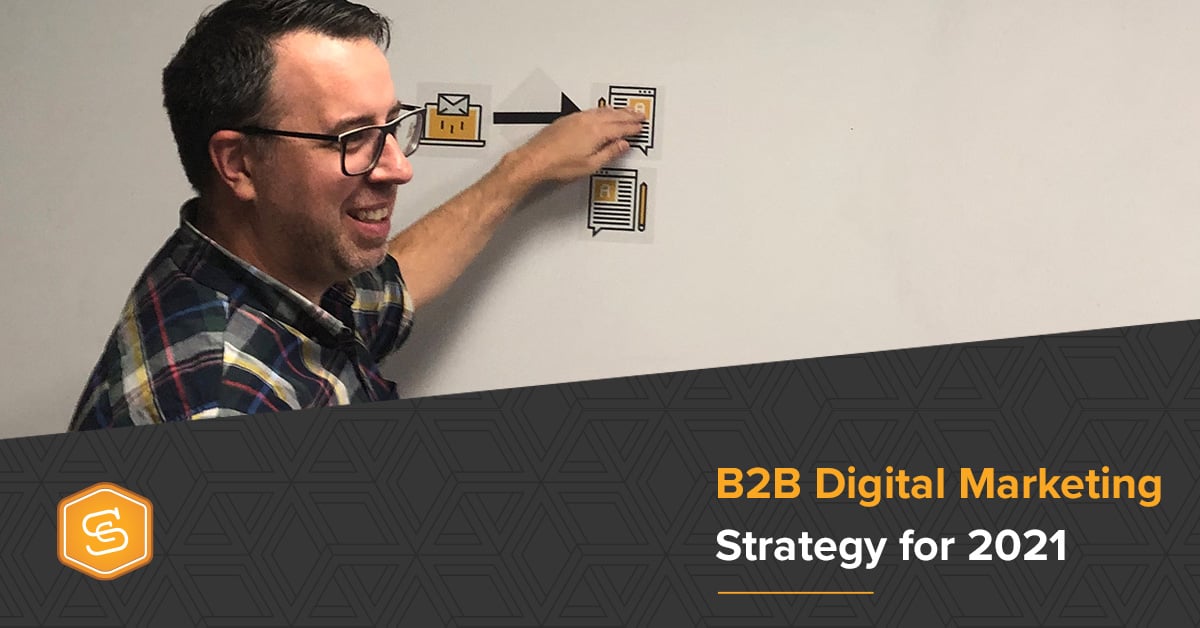
Chances are your organization’s sales and marketing strategy changed dramatically in 2020. COVID-19 forced many non-essential B2B companies to work-from-home, and nearly all business trips got grounded and in-person events like trade shows and business seminars came to a screeching halt.
As a result, modalities shifted on educating potential customers and engaging them in the sales process. This was especially true for the manufacturing segment, where, in the past, 65% of have reportedly used in-person events in their content marketing efforts.
What have we learned from 2022 that will impact marketing and budgets for 2023?
In this article, we’ll not only make some predictions on the digital strategies and trends to consider for 2023, but we’ll also give you a framework for solidifying an effective B2B digital marketing strategy both now and well into the future.
What is a B2B Digital Marketing Strategy?
It’s essential to understand what is meant by and involved with a business-to-business digital marketing strategy. In this article, HubSpot defines a digital marketing strategy as “a plan that helps your business achieve specific digital goals through carefully selected online marketing channels such as paid, earned, and owned media.”
Let’s look at some of the critical aspects of this definition and expand upon them:
- Specific digital goals: these are designed to reach users of electronic devices and apps to connect, engage, and share valuable information with them.
- Carefully selected online marketing channels: these are channels relative to your buyer personas and take into account the access they have to multiple screens and devices such as smartphones, tablets, laptops, desktops, and TVs.
- Paid, earned, and owned media: these, taken together, form a converged media strategy that allows digital marketers to gain a holistic view of their dynamic customers to engage them wherever they are, and however they choose. Go here for a description, examples and benefits of using each of these media channels in an effective digital marketing strategy.
- B2B/B2G/B2C: In a B2B digital marketing scenario, a business markets and sells exclusively to other businesses -- these are typically characterized by a high-touch, consultative approach, and longer-term sales cycles. B2G is where a company sells primarily to a government agency. These engagements can also be high-touch and relational and may involve meeting government standards through a bid or formal proposal process. B2C, of course, means the business sells to consumers, and these are typically seen as transactional processes involving the four Ps of marketing: product, promotion, place, and price.
Moreover, there’s a common misconception that digital marketing only involves attracting ideal prospects to a businesses owned media, such as their website or social media channels. It involves a great deal more. Beyond merely attracting new opportunities, a digital marketing plan must also convert them to leads, customers, and promoters, which we covered in detail on adopting a digital marketing template approach.
The goals and calls to action of digital marketing were not only crafted to support online engagements but offline, too. For example, in a 2019 study, the Content Marketing Institute found that marketers successfully used digital content marketing to secure and convert leads at in-person events. But those applications are most likely over, for now.
As of the writing of this article, coronavirus cases and hospitalizations were relentlessly on the rise. With so much uncertainty about the future, budgets and marketing plans will undoubtedly need to shift all the more from in-person events and business-related travel to what you can get done through the Internet. And, with some keen planning and imagination, you may find, you can accomplish a great deal.
B2B Digital Marketing Strategies & Trends for 2023: Best Of
Many of the B2B digital marketing strategies and tactics you’ve deployed for growing your business over the past several years are still in play for 2023. Think of these as staples that aren’t going away anytime soon, such as:
- B2B content marketing - 2021 - what now?
- Email marketing - the ultimate guide
- Top ten SEO plan for higher search rankings in 2021
Along with these (and other staples), you may also want to train your eye on some emerging trends for 2023 B2B digital marketing. Here’s a best-of list:
B2B digital ads
LinkedIn, the premier social media network for the B2B segment, reports B2B marketers are leaning more heavily on search and social media ads. This is especially true in healthcare (up 41%) and the event space with the widespread cancellation of in-person events, which leads to the next trend...
Virtual events
With B2B virtual events, the possibilities are endless with online webinars, trade shows, conventions, and so on. Delegate, an online event planning platform, lists 8 virtual event ideas for 2021. They also discuss the benefits and types of virtual events here. It may also be a good idea to look into LinkedIn Events, which has everything you need to plan and execute public and private virtual events.
Chatbots, AI and conversational selling
With careful planning around data and what customers care about (artificial intelligence), chatbots can be a useful engagement tool. TopRank Marketing co-founder and CEO Lee Oden included chatbots and conversational selling in a list of top B2B digital marketing trends for 2020. He points out how “B2B marketers are using chatbots to filter content, provide basic support, capture contact information, and nurture leads without much if any, human involvement.”
Forbes has a thought-provoking article on incorporating chatbot technology in digital marketing now and post-pandemic. It offers practical advice like, “As you look to implement a chatbot solution, particularly around Covid-19 support, be sure to remember that bots are artificial intelligence, but those dealing with them on the other end are not. Think from a human perspective.”
Video and Visual Content
Now, perhaps more than ever before, visual content marketing is king. And, if Oden thought to include this in his top 10 list for B2B digital marketers in 2020, we can’t ignore or think it doesn’t matter for 2023 and beyond. To this point, consider the following:
- HubSpot reports 53% want to see more videos in the future, and 62% say they thoroughly consume video - more than any other content type
- A Cisco study found 80% of the world’s Internet traffic will be video by 2021
- A report from Google and Ipsos revealed 64% of B2B buyers had increased their use of online video during the pandemic
What better way to get inspired and fuel your imagination than to view a video on B2B video marketing for 2023? Check out this short video for ten B2B video marketing ideas.
Engage the Millennial B2B buyer
Lastly, we’ll leave you with some thoughts on who to create your 2023 (and beyond) digital marketing strategies, messaging, and campaigns for: the Millennials, aka Digital Natives.
According to this Harvard Business Review article, “Some 73% of 20- to 35-year-olds are involved in product or service purchase decision-making at their companies...and about half of all product researches are digital natives.”
Even as far back as 2018, Millennials were said to dominate the B2B buying process, with over 45% (the largest single demographic) of B2B technology buyers falling in the digital native segment. Understanding who Millennials are and how they impact the B2B buying process will help you better shape your digital marketing not just for 2023 but well into the future.
Here are some resources to help:
- Millennial B2B Buyers: What you need to know about the new wave of decision makers
- How Digital Natives are Changing B2B Purchasing
- B2B Report on Millennials by Merit (PDF)
- B2B Marketing: 3 Tactics to Reach Millennials
What do these staple strategies and emerging trends mean to your B2B digital marketing plan? Will you incorporate more video and virtual events into your mix? How will you execute to more effectively engage the B2B Millennial buyer?
Developing Your Digital Marketing Strategy for 2023
Your first step to establish a digital marketing strategy and budget should be to analyze the ROI from this/last year’s initiatives and any course corrections you made.
If you’re new to calculating the ROI from marketing initiatives, check out our article on how to calculate ROI for an easy-to-use formula.
What were your successes? Failures? Did you meet, exceed, or fall short of your ROI and strategy goals? Were there any unexpected outcomes, good or bad, that may influence strategy for the upcoming year?
Keep in mind, your buyer personas may need to be updated, especially with the trend of more Millenials in positions of research and decision-making.
Set goals
Next, you’ll want to set (SMART) goals for each stage of the marketing funnel:
- How many visitors do you want to attract to your owned media channels?
- How many visitors do you want to convert to sales-ready leads?
- How many leads will you close to become customers?
- How many customers will you nurture to become promoters?
Determine strategies/objectives
Once you’ve established your goals, move on to determine the strategies you’ll use to reach them. Whereas goals detail what you want to achieve, strategies define the methods or approaches you may take to arrive at your stated objectives.
For example, you may have a goal to achieve 500 new leads by the end of 2023. To achieve this goal, you’ll use a combination of virtual events and video (the strategies). Note that it works best to have a singular goal in each of the funnel stages, but you could have multiple strategies at work to achieve it.
Select tactics
Finally, determine what tactics you’ll deploy to support each of the strategies selected. Again, you can have multiple tactics for each strategy. For instance, with a strategy to engage in virtual events, you may decide tactically to do virtual conferences, product launches, and trade shows.
Likewise, with the strategy to produce and publish video to meet your lead generation goal, your tactics may include thought leadership videos, how-to videos, and product demo videos.
Setting your digital marketing plan during or following a pandemic won’t be easy. And you’d be wise to anticipate changes by building contingencies and some fluidity into your plan. All things considered, though, being aware of the above strategies and trends and how to put them together in a cohesive plan should give you an edge in your marketplace.
With that in mind, we’ve put together a practical worksheet you can download for free to help you in the process. Just click the link below to get started right now.
Now I turn it over to you. What digital marketing trends are you using in 2023?





